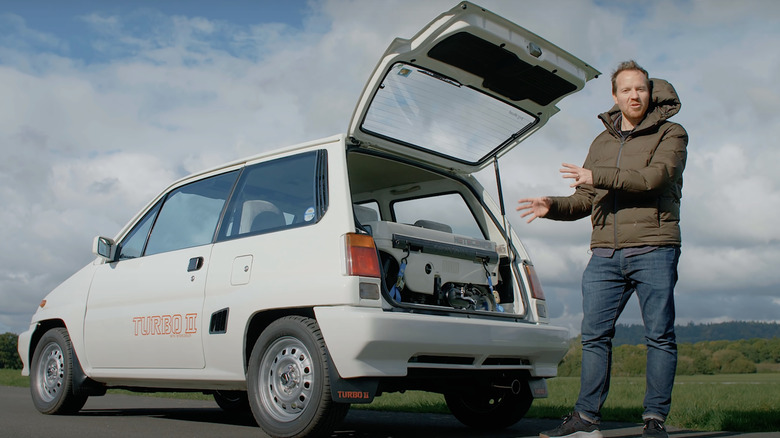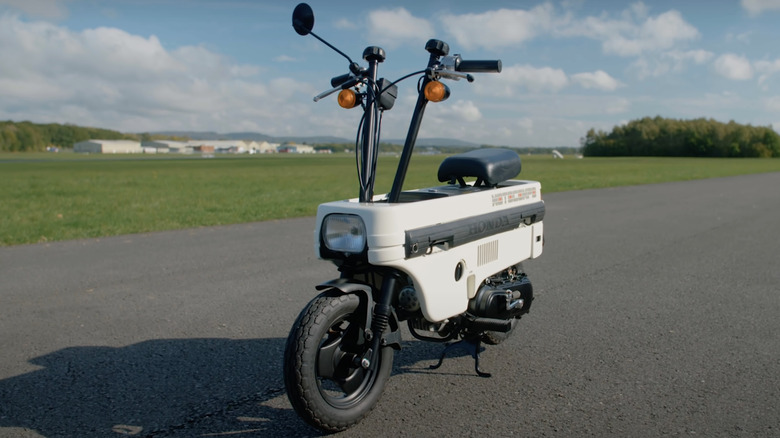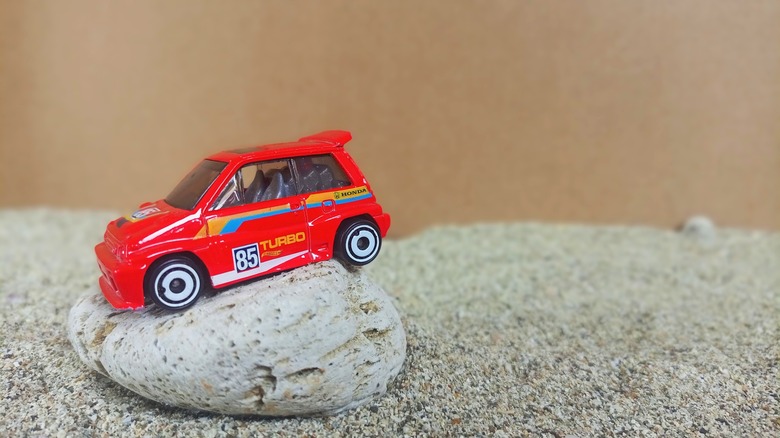The Mini Honda City Turbo II That Has Never Made It To The US
In many ways, the Honda City Turbo II felt like something straight out of a fever dream. When it was first launched in Japan in 1983, the sporty hatchback was a small car, at 3.42-meter length and 1.62-meter width, that had big dreams. It could clock in at a maximum speed of 109 mph and accelerate to 62 mph in an estimated 8.6 seconds. While that was reasonably fast at the time, its size and speed wasn't the only thing that made it stand apart from the crowd. It also had a lot of quirky remnants of the '80s, such as its eight-bit processor, cassette player, and cassette tape holding compartment. It also had a refrigerated glove box that could fit quite a few drinks, which is an add-on that even drivers of today would be happy to have in their car during the blistering summers.
However, it's the addition of the Honda Motocompo scooter made to fit its trunk perfectly that took the cake and cemented its fan base. Although the 2.5 horsepower scooter was a thoughtful addition, it wasn't entirely a practical choice. It was actually quite heavy at 99 pounds and took up way too much room in the Honda City Turbo II's already-limited trunk space. That being said, the Honda City Turbo II is overall an interesting car, so what's the reason it was never released in the United States?
Why the Honda City Turbo II wasn't meant for the United States
When evaluating why the Honda City Turbo II never made it to America, there are a lot of factors at play, including how likely it fits an existing need in the market. Because cars are typically designed for certain lifestyles, it's important to note that the Honda City Turbo II was designed for a different kind of city life.
In the United States, car ownership is the norm, so many Americans typically have garage spaces built into their suburban homes or access to parking facilities near their work or school. However, this isn't necessarily the same for everyone else, especially in Japan's urban condo-dwelling market. While Japan also has a high rate of car ownership, one of the key differences is that having off-site parking is quite common in city centers like Tokyo. Apart from not having a government mandate to provide on-site parking for new residential developments, it is also due to limited space. Because of this, the addition of the scooter makes perfect sense as a half-way solution between their homes and the parking spot they rent outside of it.
Unfortunately, the Honda City Turbo II isn't the only tiny but brilliant car that was never released in North America. Other beloved small cars that never made it to American shores include the Fiat Panda, Toyota Aygo, Honda N-Box, and the Audi A1. But, why are American consumers so averse to smaller vehicles anyway?
Why are Americans against small cars?
Bigger isn't necessarily better, but when it comes to cars, this may still be the case. According to the Environmental Protection Agency (EPA)'s 2022 EPA Automotive Trends Report [PDF], the average weight of new vehicles in 2021 are over a 100 pounds heavier than in 2004. The reason why small cars just keep getting bigger is a cocktail of legislation, safety, and technological advantages.
In general, it's widely believed that you're more likely to survive a car crash in a larger vehicle, and this usually holds true on many accounts. For example, the Insurance Institute for Highway Safety (IIHS) shares that four out of the top five vehicles with the highest driver death rates in 2023 are mini cars: the Mitsubishi Mirage G4, Mitsubishi Mirage hatchback, Hyundai Accent, and the Chevrolet Spark. In the same report, the IIHS also lists vehicles with the lowest death rates to be primarily midsize SUVs.
However, this story isn't always black and white. As our team at SlashGear reported in 2023, bulky muscle cars are actually some of the most likely cars that can get you killed in a car accident. Given that many muscle cars are marketed for their power, it isn't surprising that it can encourage more reckless driving behavior from its drivers. Not to mention, big pickups have a higher chance of killing their drivers, as well as the drivers of the cars they end up crashing into.
How the Honda City Turbo II lives on
While it's no longer in production, the Honda City Turbo II isn't truly dead. Affectionately referred to as the "Bulldog," the turbocharged Turbo II has graced several iterations of the Gran Turismo racing game. Inspiring a following among players of the series, there are even cases of fans buying them out of nostalgia. Not to mention, diecast models of it are still being sold to collectors globally.
Although the little add-on scooter wasn't enough to save the Honda City Turbo II from ceasing production in 1986, Honda did surprise everyone by releasing an electric version of its foldable Motocompacto just last year. Similar to its predecessor, it's still designed as a last-mile sort of scooter that is more appropriate for short trips to the grocery or the gym than going on road trips. That being said, our team at SlashGear had a lot of fun with the Motocompacto scooter during our field test and praised the weight Honda put on, adding safety features that are absent from other scooters like it.
And perhaps, one of the most surprising developments is its influence on the undeniably cute Honda e, which is reminiscent of the Turbo II's charm. As if in irony, the Honda e is also another small electric car that isn't being sold in the United States. Regardless, the resurrection of the compact pair somewhat feels almost like they are reborn in a time wherein consumers can finally value what it offers.



